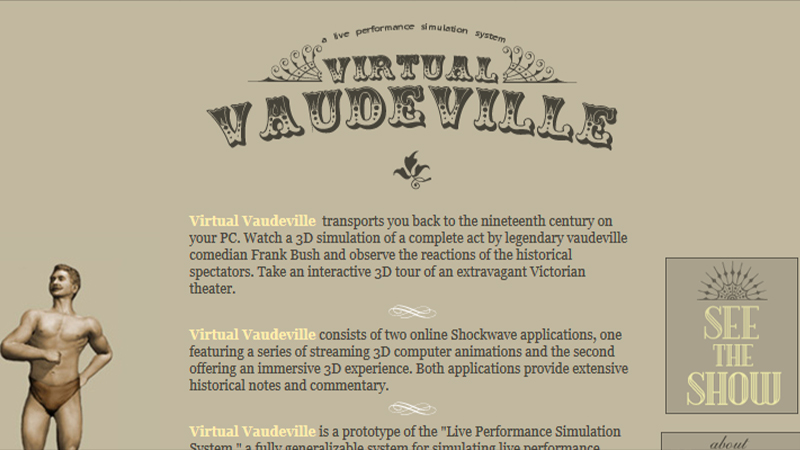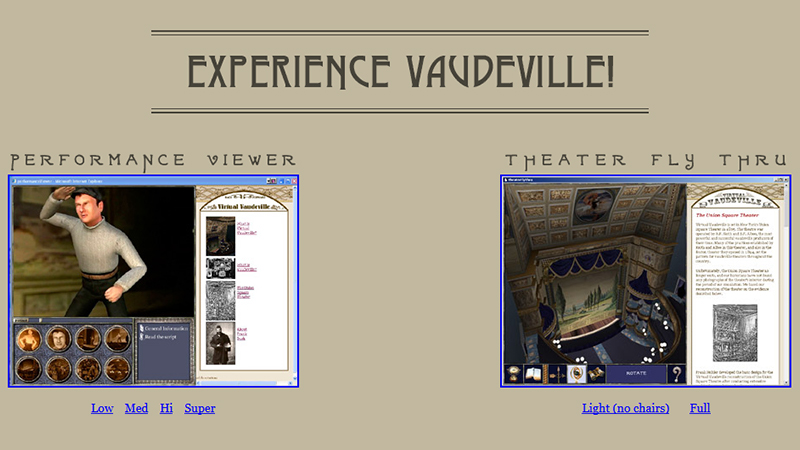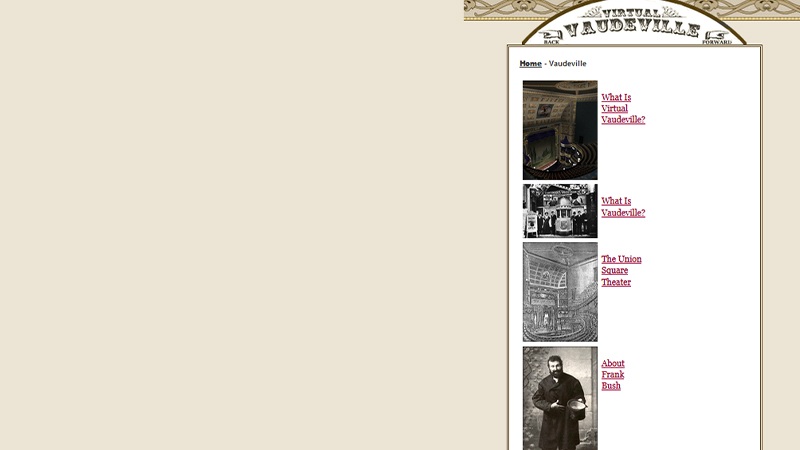Editor's Introduction
"It is easy to see how the emerging technologies of the entertainment industries such as motion capture, 3D modeling and video game engines are changing the worlds of cinema, animation, music video, and game design, but their impact on digital historiography and multimedia scholarship is perhaps less apparent. A notable exception may be found in David Saltz's Virtual Vaudeville, which offers a unique melding of technology offers a unique melding of technology and history that takes full advantage of [emerging] technologies in order to capture and recreate a highly ephemeral slice of American history: the 19th and early 20th century vaudeville theater.
But Virtual Vaudeville does more than attempt to simply bring this history to life in the manner of a Hollywood epic. The 3D spaces and performances recreated by Virtual Vaudeville are available to users from multiple points of view, which makes it possible to focus on not just the performers, but the architectural spaces of the long since demolished Union Square Theater or, importantly, the boisterous, segregated audiences who turned out to see the show. This interactive, multi-perspectival platform allows Virtual Vaudeville to move beyond simply creating a historical fetish object focused on specific figures – e.g., the project's inaugural performers, Jewish comedian Frank Bush or strongman Eugen Sandow – to speak to issues of race, ethnicity, class and historiography.
As part of an ongoing research project, Virtual Vaudeville also models a prototype 'Live Performance Simulation System,' which promises to generalize its historical rendering capabilities to other types of performances or historical events. In the context of this issue of Vectors, Virtual Vaudeville is of particular interest as a model for using digital technology to generate new forms of evidence and extraordinary potentials for exploring them. The project thus functions as both a meticulously researched scholarly artifact and a tool-in-progress that may well prove foundational to an emerging field of historical visualization." -- Tara McPherson and Steve Anderson, Vectors Editors
Author's Statement
"Manuscripts, paintings, sculptures, films, and recordings are artifacts that can be preserved and archived for future generations. Live theatre, however, is ephemeral. This simple fact creates a tremendous challenge for theatre historiography and pedagogy. One consequence is that scholars and teachers have traditionally neglected theatrical forms, such as American vaudeville, that emphasized transitory performative and visual elements over relatively durable dramatic texts.
In an effort to compensate for theatre's evanescence, scholars and theatre artists have tried to simulate historical theatre events. One approach is to build a physical reconstruction of an historic structure and to stage performances in it, as has been done, for example, with the Globe Theatre in London. This solution requires an extraordinary, continuing investment of money and land. Perhaps the deepest problem with such historical constructions is that, while painstaking efforts may be undertaken to achieve historical accuracy in the physical environment and performances, the audience itself, and so, ultimately, the context of reception, remains resolutely contemporary.
Another common approach to simulating historical performance is to use film or video. But film is incapable of conveying the experience of attending a live performance. A filmed performance offers only a single perspective on the action: the camera decides exactly where to look at each moment. Spectators at a live event, by contrast, act as their own camera operators, selecting their own point of focus - which may not even be on stage. Films omit a vital dimension of live performance: the viewer's immersion in the world of the theatre, and the crucial role that the community of spectators plays in constituting a performance event.
Virtual Vaudeville represents a new approach to simulating historical performances. It uses 3D gaming technologies to transport scholars and students back to the nineteenth century on their computers. Users can watch a rigorously researched recreation of a vaudeville performance from 1895, moving through a richly detailed theater to explore the architecture, stage performers, and the reactions of 800 spectators. The project, centered at the University of Georgia, draws on an interdisciplinary team of historians, digital artists, motion capture specialists, programmers, and theatre practitioners from seven universities across the United States. The initial phase of the project, which started in January 2002, was supported by a three-year grant from the National Science Foundation with additional funding from a Georgia Lottery Equipment Grant and the Georgia Research Alliance.
Virtual Vaudeville is a prototype of the 'Live Performance Simulation System,' a fully generalizable system for simulating live performances from any historical period, from theatrical events such classical Greece to Japanese Noh drama, to paratheatrical performances such as dance, ritual, political congresses, coronations, parades and battles.
American vaudeville is an apt test case for Live Performance Simulation. Vaudeville was the most popular form of entertainment in the United States from the 1880s through the 1920s, functioning in its day much as television does today. Many vaudeville acts both reflected and helped to constitute the enthusiasms and anxieties of their time, especially those concerning the integration of new immigrant groups into mainstream American culture. Consequently, a rich simulation of a vaudeville performance would be a useful resource, not just for those interested in theatre history, but for scholars and students of American history generally.
Our simulated performance takes place in B. F. Keith's Union Square Theatre in the year 1895, fifteen years after the first vaudeville theatre opened in New York. Virtual Vaudeville currently features a complete act by Frank Bush, one of America's most popular comedians in the late nineteenth century. Bush's brand of humor exemplifies the ethnic comedy that dominated the American stage, appealing especially to the large population of working-class immigrants in big cities such as New York, Boston and Chicago. A gentile comedian of German descent, Bush portrayed a wide variety of ethnic stereotypes, often performing multiple characters in a single routine. In the act recreated for Virtual Vaudeville, Bush first portrays an Irishman and then his famous 'stage Jew,' a characterization that set the pattern for subsequent representations of Jews in American popular entertainment.
We have completed research and created scripts for three additional acts representative of the vaudeville circuit during that time: (1) the strongman Sandow the Magnificent; (2) the Irish singer, Maggie Cline; and (3) a 30-minute musical-comedy sketch called Running for Office by the four Cohans, whose youngest member, George M. Cohan, went on to become one of the great stars of early 20th century Broadway. We will complete our simulations of these additional acts as funding allows.
Significance
Virtual Vaudeville offers scholars in all disciplines of the humanities a model for a new kind of 'critical edition.' A conventional published monograph can pick and choose details to examine, and so lacuna and even contradictions in the historical analysis are easy to overlook. The imperative of precisely recreating both onstage and offstage events demands the highest degree of scholarly thoroughness and rigor.
Key to Virtual Vaudeville is the depth of the collaboration between technology, scholarship, pedagogy and art. This project was conceived to make a significant contribution to all four domains simultaneously, rather than merely using any one in the service of the others. The end result, we believe, represents an important advance in the design and implementation of virtual environments, building on recent successes in creating photo-realistic simulations of real 3D environments by introducing a large quantity of complex human performance data. It constitutes a significant work of applied scholarship and a unique resource for students to engage with historical performance traditions as performance, rather than as literature or film. Finally, from an artistic perspective, the Virtual Vaudeville project tests the potential of the internet as a venue for nuanced and engaging theatre experiences. -- David Saltz
David Z. Saltz, Principal Investigator of the Virtual Vaudeville project, is Head of the Department of Theatre and Film Studies at the University of Georgia. As founding director of the Interactive Performance Lab, he has directed theatrical productions and created interactive installations incorporating interactive technologies such as motion capture and robotics. He has also published many essays about the theory of live performance and digital technology in journals and encyclopedias such as Theatre Research International, Performance Research, The Journal of Aesthetics and Art Criticism, the Oxford Encyclopedia of Theatre and Performance." -- from Vectors, Volume 1, Issue 1, Fall 2005
Designer's Statement
"Design
The Virtual Vaudeville simulation consists of (1) the theatre; (2) the performance and (3) spectators reacting to the performance.
B.F. Keith's 1,200-seat Union Square Theatre was one of the largest and most influential vaudeville venues in the country. Unfortunately, the theatre was demolished many years ago, and little documentation survives. The Virtual Vaudeville model of the theatre is based on floorplans, etchings and newspaper descriptions. The theatre's elaborate ornamentation was reconstructed from high-resolution photographs of recently restored theatre buildings from the period. Hypermedia notes provide both the archival and photographic sources used in the reconstruction. For example, the viewer can click on a door, a painting or a molding to discover that element's photographic source.
The challenge in creating 3D animations of the performance itself is two-fold. First, a likeness of the original performer must be created from a limited set of inadequately detailed black and white photographs. The greater challenge is to bring the vitality of a great stage performance into the virtual environment. To this end, we are using optical motion and facial capture technology to capture real-world performances by professional, highly skilled performers.
The Union Square Theatre, according to our estimates, would have held approximately 800 spectators during a typical afternoon performance. Our goal has been to reflect the demographics of the audience as precisely as possible, showing the distribution of gender, class and ethnicity in various parts of the theatre. Not only do we need to fill the seats with historically accurate and convincing faces and costumes, but we need to animate all the spectators so they respond to every moment of every act in a way consistent with their demographic profile. For example, when Frank Bush portrays his Irish character, the Irish spectators in the gallery - a notoriously boisterous group - should respond very differently from the WASP characters in the boxes. To create 800 distinct models, with 800 distinct animations, would not only be an awesomely onerous task, but would be impossible for the program to handle in real-time. Our solution has been to define 32 basic audience groups, for example, one group of upper class WASP men, and another of middle class African-American women, and we have scripted and animated responses for each of these groups. We then created from three to five physical variations for each group (i.e., three to five different faces and costumes), and produced even more variation by adding and subtracting hats and facial hair.
The ultimate goal is to deliver the 3D vaudeville simulation in a fully-immersive environment that allows the viewer to fly through the theatre and watch the performance from any vantage point, and to observe the reaction of any of the 800 spectators at any time. We have, in fact, produced a functional prototype of such an environment using a professional-grade game engine, Gamebyro, but this prototype does not run over the internet and requires a top-of-the-line PC running Windows.
To make the Virtual Vaudeville content immediately available to the widest possible audience, we have developed two applications in Shockwave that run over the internet on either Windows or Mac OS X. The first application is the Performance Viewer, which delivers streaming video of the simulated performance (at this point approximately 10 minutes long). The Performance Viewer allows the viewer to switch at any time between any of eight pre-rendered animations of the performance from different perspectives, for example a close-up of the performer's face, a view of the stage from the second balcony, or a pan of the spectators watching the performance in the gallery. The second application is the Theatre Fly Thru, which allows viewer to navigate freely through the empty Union Square Theatre to scrutinize any architectural detail. Both applications incorporate extensive hypermedia notes.
Pitfalls of Simulation
Computer simulations of performance spaces and performers are powerful research and teaching tools, but carry inherent dangers. Vividly simulated theatres and performances produce the sensation that the viewer has been transported back in time and is experiencing the performance event 'as it really was.' While compelling, this impression is seriously misleading. It conceals the hypothetical and provisional nature of historical interpretation and implicitly reinforces an outdated positivist view of history. Moreover, even if all of the physical details of the simulation were perfectly accurate (which is impossible), a present-day viewer's experience would nonetheless be radically different from that of the original audience because the cultural context of reception has changed radically.
Virtual Vaudeville makes a concerted effort to counteract these positivistic tendencies through a design that deliberately balances immersion with hypermediality. In both the Performance Viewer and the Theatre Fly-thru applications, the simulation is presented in a window alongside the interface elements and the hypermedia browser, with the hypermedia notes supplying contextual information and, most importantly, access to the historical evidence upon which the reconstructions are based. Viewers are put in a position to assess the countless historical interpretations and extrapolations we have made in creating the simulation, and to arrive at their own alternative interpretations of the evidence." -- David Saltz, from Vectors, Volume 1, Issue 1, Fall 2005
Project Credits
"Principal Investigator: David Z. Saltz, University of Georgia
Performance Historians / Hypermedia Editorial Board: Charles B. Davis, University of Georgia (Frank Bush); Susan Kattwinkel, College of Charleston (The Four Cohans, Maggie Cline); Bruce McConachie, University of Pittsburgh (nineteenth century audience); Frank Mohler, Appalachian State University (theatre architecture); David Z. Saltz, University of Georgia, (General Editor and architectural ornamentation); Larry Worster, Metropolitan State College of Denver (vaudeville music)
Production (University of Georgia): Tina Hantula (costumes); David Z. Saltz (stage/motion capture direction); Rachel Townes (musical direction); Mark Wheeler (choreography)
Performers (University of Georgia): George Contini (Frank Bush voice and motion capture; appears curtesy of SAG); Adam Gordon, Nathan Henderson, David Spearman (Sandow motion capture)
CG Artists (University of Georgia): Carl Ahlund (character models, animation, textures, web design), Vincent Argentina (Lead Animator, character and architectural models, animation, textures, motion capture), Ola Gardner (spectator textures), Anna Gallaspy (spectator models and textures)
Digital Audio (University of Georgia): Vincent Argentina, Joelle Arp-Dunham, Phil Bergquist
Online Performance Viewer and Theatre Fly-thru Applications (University of Georgia): Vincent Argentina (programming and interface design); Carl Ahlund (button design)
Full Performance Simulation Application (Georgia Institute of Technology; in development): Maribeth Gandy, Edward Price, Scott L. Robertson
Agent Based Interactions (Moves Institute, Naval Postgraduate School; in development): Michael Zyda, John Hiles, Brian Osborne, Mike Bailey
Consultants: Larry Hill, Western Carolina University; Michael Hussey, University of Georgia; Sylvia Pannell, University of Georgia; Allen Partridge, University of Georgia; Scott Shamp, University of Georgia; Dan Zellner, Artistic Director of Studio Z, Chicago
Graduate Assistants: Joelle Arp-Dunham, University of Georgia; Michelle Sullivan, University of Pittsburgh" -- from Vectors, Volume 1, Issue 1, Fall 2005
1 COPY IN THE NEXT
Published in Fall, 2005 by Vectors in Volume 1, Issue 1.
This copy was given to the Electronic Literature Lab by Erik Loyer in November of 2021.
PUBLICATION TYPE
Online Journal
COPY MEDIA FORMAT
Web



